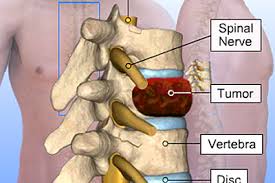What is
Spine Tumor
A spine tumor is a growth of cells (a mass) within the bones of the spine (vertebrae) or around the spinal cord (the column of nerves that control the limbs). Tumors are either benign or malignant. Benign spine tumors do not spread from their original location but may be “locally aggressive.” Malignant tumors are cancers that can spread their cancer cells to other parts of the body. Whether the tumor spreads or not, a spine tumor can threaten life, irritate or injure the spinal cord and nerves, and cause permanent disability. Most malignant tumors of the spine are a result of spread from another site (such as breast, prostate, lung, thyroid, kidney or gastrointestinal tract).
Malignant (cancerous) tumors can spread to other parts of the body. They may arise in the spine or they may arise from other parts of the body and travel to the spine. The most common malignant tumors arising in the spine are chondrosarcoma, Ewing’s sarcoma, lymphoma, osteosarcoma, and multiple myeloma/plasmacytoma. Many tumors found in the spine have spread from other parts of the body, most commonly due to breast cancer, prostate cancer, lung cancer, thyroid cancer, kidney cancer, or cancer from the gastrointestinal tract.
All types of spinal tumors can be life or mobility threatening, given the importance of the normal structures of the nervous system that the spine contains, such as the spinal cord and spinal nerve roots.
Risk factors for spine tumors include certain genetic conditions such as neurofibromatosis and a prior history of cancer, particularly of the breast, prostate, lung, thyroid, and kidney.

What are the Symptoms of Spine Tumors?
Symptoms of spine tumors typically include pain or weakness. The vast majority of patients complain of constant “aching” or “gnawing” pain localized to the location of the tumor mechanical pain around the tumor aggravated by movement, or radiating “shooting” nerve pain (down the arms, legs or around the chest and belly) related to nerves that are irritated or compressed by the tumor. Patients may also feel night time pain preventing them from sleeping and or experience night sweats and chills. Some patients may experience weakness in the arms or legs due to compression of nerves or spinal cord. In some cases, the compression may lead to problems with urine function, sexual function, or bowel function. Some patients may have a tumor diagnosed by a test and could experience no symptoms at all.
How is a Spinal Tumor Diagnosed?

The first step in the evaluation of a spinal tumor is to get a detailed history. The doctor will perform a physical examination. This may include checking for swelling, tenderness and other possible sites of involvement as well as evaluating motion, alignment and strength of arms and legs. A neurologic examination may also be done. This may include tests of sensory (temperature, pain and pressure sensitivity), motor (muscle strength) and reflex functions of the nervous system. In addition, X-rays may be necessary to look for tumors or dislocations. Other tests such as Bone Scans can identify tumors months before X-rays. Often computed tomography (CT) or magnetic resonance imaging (MRI) scans may be ordered to determine the extent of disease. In an effort to determine the origin of the tumor and whether it is benign or malignant, you will need a biopsy. The biopsy can be done in the x-ray department by a radiologist or in the operating room by the surgeon. Sometimes the biopsy is done at the same time as the treatment.
Treatment options for spinal tumors depend on the type of tumor and the extent of the disease. Benign tumors that cause no symptoms may need nothing more than close observation. Tumors that arise from other sites (metastatic) may be treated with chemotherapy or radiation treatment. Most tumors that are causing severe pain, spinal curvatures, or compression of nerves or spinal cord are treated with surgery.
What are the Surgical Options for Spine Tumors?
iSPINE works collaboratively with experienced spine surgeons that can evaluate you for any surgical interventions
A number of surgical techniques are employed to reduce tumor size, decompress the spinal cord and nerves of the spine, and stabilize the bony elements of the spine in a more normal position. Many times minimally invasive techniques can be employed to minimize blood loss, infection, and recovery time. Modern techniques even allow for outpatient delivery of computer guided thermal energy to a spinal tumor to destroy it, performed through a large needle. This can be done in conjunction with a vertebral augmentation procedure, where bone cement is injected into the affected spinal bone to stabilize it and reduce or eliminate pain. The use of robotics in surgery can improve accuracy and efficacy of surgery for spinal tumors. Seeking care from a physician with experience providing all types of surgical care for tumors of the spine is very important to experience the best result with the lowest risk of a complication.
What are the Treatment Options for Spine Tumors?

Request An APPOITMENT
Fell free to contact us with any questions or concern regarding Back/Neck pain.